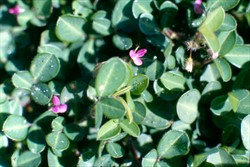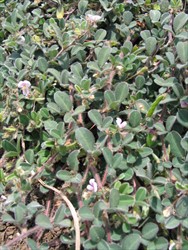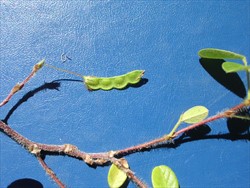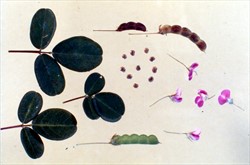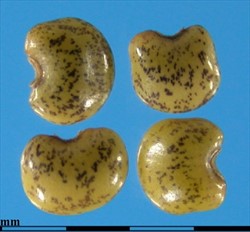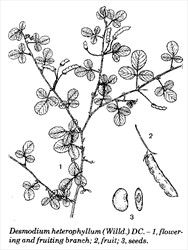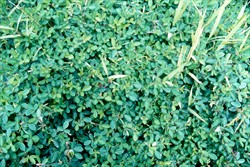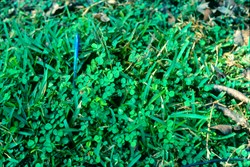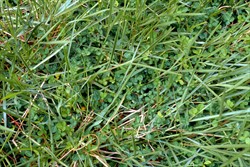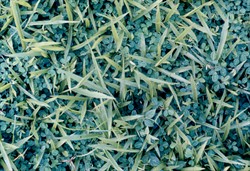Tropical Forages
Basionym: Hedysarum heterophyllum Willd.; Desmodium heterophyllum (Willd.) DC.; Meibomia heterophylla (Willd.) Kuntze
Family: Fabaceae (alt. Leguminosae) subfamily: Faboideae tribe: Desmodieae.
Prostrate perennial, 10‒70 cm tall, multi-branching, strongly stoloniferous, rooting freely from stolons and lower nodes of aerial stems. Stems up to 1.5 m long, angular, reddish-brown, tomentose, with spreading brown hairs 1.5–2.0 mm long. Stolons become woody with age and almost glabrous. Leaves trifoliolate, often intermixed with unifoliolate leaves on lower part, petioles angular, 5‒15 mm long. Terminal leaflet 10–30 mm long and 8–15 mm wide, larger than lateral leaflets (12–15 mm long and 8–10 mm wide). Leaflets obovate or elliptical, margins entire, apex slightly emarginate, reticulate venation, densely pubescent (hairs whitish coloured) on both dorsal and ventral surfaces. Petiolule of the terminal leaflet 4–5 times longer than those of lateral leaflets. Inflorescence a few-flowered axillary or terminal raceme to 6 cm long, and/or leaf-opposed clusters of 1‒3 flowers; pedicel 10‒25 mm long. Flowers small (3–5 mm long), pink, purple or white, giving rise to a 3–6 jointed, undulate (on dorsal edge) pod, which fractures at the joints on maturity. Pods 12–25 mm long, 4–5 mm wide, finely pubescent. Segments oblong or quadrate, densely covered with minute hooked hairs; when segments break, they stick to hair or clothing when ripe (hence name of tick trefoil). Seeds kidney shaped, 2.25–2.50 mm long and 1.50–1.75 mm wide, yellowish brown turning dark brown with age; seed coat glabrous. About 325,000 seeds per kg.
Similar species
Grona heterophylla: terminal leaflet broadly elliptic or broadly elliptic-obovate, 10–30 mm long and 8–15 mm wide, base obtuse, apex rounded or nearly truncate, often emarginate; silver blaze on midrib common.
Grona triflora: terminal leaflet obcordate, obtriangular, or obovate, 2.5–10 mm long and 2.5–10 mm wide, base cuneate, apex truncate, slightly emarginate; silver blaze absent.
Asia: Smau ‘âm’bôk, trôm’ préi (Cambodia); 异叶山蚂蝗 yi ye shan ma huang (China); sisik betook, heuheulangan, sukut jareman (Indonesia); kawariba-makie-hagi (Japan); padông môd liinz (Laos); akar sisik naga, akar telinga tikus, kekara, omba-omba, peparu bendang, rumput sisik naga, rumput sisek betok, rumput sisek naga, rumput telinga tikus (Malaysia); kabot (Sarawak); ya maengmi (Thailand); hàn the, thóc lép khác lá, tràng quả dị diệp (Vietnam)
English: hetero, greater clover-leafed desmodium, Guinea clover, Japanese tick-clover, Spanish clover; variable-leaf tick trefoil (USA)
Indian subcontinent: tellausiri (India); මහ උඳුපියළිය maha undupiyaliya (Sinhala); perumpulladi (Tamil)
Latin America: desmodium hetero, trébol japonés
Pacific: senivakacegu, wakutu (Fiji)
Native:
Asia: Cambodia, China, India, Indonesia, Japan (Ryukyu Islands (s.)), Laos, Malaysia, Myanmar, Nepal, Philippines, Sri Lanka, Taiwan, Thailand, Vietnam
Papuasia: Papua New Guinea
Naturalized:
Australasia/Papuasia: Australia (Queensland), Solomon Islands
Pacific: Fiji, Hawaii, Micronesia, Northern Mariana Islands
Forage
Valuable component of grazed native pastures and of sown pastures dominated by creeping grasses. Tolerance to spread under heavy grazing allows it to persist under conditions of management that result in the loss of most other legumes.
Environment
It has been used as ground cover in pepper gardens in Sarawak (Malaysia).
Other
Roots, twigs and leaves are used in Cambodian and Indian folk medicine to treat various conditions.
Soil requirements
Grows on a wide range of soils from sands to clays with pH 4.5‒7.5. Very efficient at extracting phosphorus from infertile soils. Will tolerate low pH and high Al; little salt tolerance.
Moisture
Requires high rainfall (at least 1,500 mm/year). Little tolerance of drought but will persist through moderate dry seasons of up to 5 months length. Tolerates waterlogged soils and short-term flooding.
Temperature
Warm-season tropical legume with no frost tolerance.
Light
Very shade tolerant and is often found under the canopy of shrubs in grassland. It persists in well-grazed pastures under mature coconut plantations and yield is less affected under 50% light than many other tropical legumes.
Reproductive development
Flowers and produces seed over a long period. As each segment of the pod dehisces at maturity, seed production is difficult.
Defoliation
Extremely tolerant of heavy grazing due to multi-branching stems that root at the nodes, and will spread under these conditions. Difficult to harvest in cut-and-carry systems due to its prostrate growth habit.
Fire
Hetero will recover after fire from plant or seed, but hetero-rich pastures with creeping grasses are rarely burnt.
Guidelines for establishment and management of sown forages.
Establishment
Can be sown from seed, but this is rarely available commercially due to difficulty of harvest. Seed should be inoculated with an appropriate rhizobium (QA 982 or CB 2085 in Australia). Almost invariably planted from cuttings of rooted stolons and stems into moist soil where it will spread rapidly due to its free branching habit and free seeding. If sown from seed, seeding rates can be as low as 0.25–0.5 kg/ha. Grazing animals spread seed through dung and from yet-to-dehisce seedpod segments adhering to hair.
Fertilizer
Hetero will grow well in infertile soils but will respond vigorously to added P (and S). Nitrogen fixation by hetero was 64 kg N and 110 kg/ha/year N with tall guinea grass (Megathrysus maximus) and Urochloa miliiformis, respectively.
Compatibility (with other species)
Depending on grazing management, hetero is incompatible with tall tussock grasses but competes well with creeping or low-growing vegetation.
Companion species
Grasses: Axonopus spp., Dichanthium caricosum, Digitaria eriantha (pangola), Paspalum notatum, Urochloa decumbens, Alysicarpus vaginalis, Grona triflora.
Pests and diseases
Susceptible to root knot nematodes (Meloidogyne spp.) on lighter soils; also affected by little leaf (mycoplasma-like organisms) and some leaf fungi, but these are rarely important under grazing. Both foliar blight (Rhizoctonia solani) and cercospora leaf-spot are observed on the species in the humid regions of Central and South America.
High tolerance of insect pests.
Ability to spread
Will spread by stolons and seed and naturalise under suitable conditions as evidenced by its spread and persistence in the Pacific region.
Weed potential
Only well adapted to heavily grazed situations, usually in association with low-growing grasses, especially with fertilizer applications, so weed potential is limited.
Nutritive value
17–18% CP; base levels are increased by P (and S) application.
Palatability/acceptability
Moderate levels of tannins reported but palatability is good, except for early growth.
Toxicity
No toxicity reported.
Dry matter
Yields of about 2 t/ha/yr have been obtained from grass-legume pastures and about 3–5 t/ha/yr under plantation crops when grown in pure stands.
Animal production
In Fiji, LWGs of over 500 kg/ha/yr recorded on fertilised hetero in native pastures. naturalized hetero invaded pastures previously fertilised and sown with Siratro (Macroptilium atropurpureum), which declined at stocking rate of 3.5 head/ha. In northern Australia, LWGs of over 700 kg/ha/yr have been obtained off signal grass (Urochloa decumbens)/hetero and pangola (Digitaria eriantha)/hetero pastures. In Samoa, LW production from a grazed (steers) Ischaemum indicum/hetero pasture was 370 kg/ha/yr vs. 220 kg/ha/yr on I. indicum alone.
2n = 22 and self-compatible, although normally cross-pollinated. At CIAT, there is a collection of about 100 germplasm accessions available, which has yet to be evaluated.
Hetero is free-seeding but harvesting is difficult because of: (1) the flowering period being much extended; (2) prostrate growth habit; and (3) seeds dehiscing from the individual pod segments soon after maturity. Consequently seed must be hand-harvested from plants over a long period of time or vacuum-harvested from the soil surface. Seed yields of 35 kg/ha have been achieved.
No information available.
- Well adapted to heavy grazing.
- Compatible with creeping grasses.
- Natural spread under grazing.
- Can be planted vegetatively.
- Good shade tolerance.
- Adapted to high rainfall regions only.
- Heavy grazing necessary to prevent suppression by grasses in the growing season.
- Low DM production.
- Difficult seed production; no commercial seed available.
Hacker, J.B. and Teitzel, J.K. (1992) Desmodium heterophyllum (Willd.) DC. In: Mannetje, L.’t and Jones, R.M. (eds) Plant Resources of South-East Asia No. 4. Forages. Pudoc Scientific Publishers, Wageningen, the Netherlands. p. 110–112. edepot.wur.nl/327785
Imrie, B.C., Jones, R.M. and Kerridge, P.C. (1983) Desmodium. In: Burt, R.L., Rotar, P.P., Walker, J.L. and Silvey, M.W. (eds) The role of Centrosema, Desmodium and Stylosanthes in improving tropical pastures. Westview Press, Boulder, CO, USA. p. 97–140.
Ohashi, H. and Ohashi, K. (2018) Grona, a Genus Separated from Desmodium (Leguminosae Tribe Desmodieae). Journal of Japanese Botany 93:104–120. jjbotany.com/pdf/JJB93-2_104-120_abstract.pdf
Partridge, I.J. (1980) The effect of grazing and superphosphate on a naturalised legume, Desmodium heterophyllum, on hill land in Fiji. Tropical Grasslands 14:63–68. bit.ly/2ULt9RS
Partridge, I.J. (1986) Effect of stocking rate and superphosphate level on an oversown fire climax grassland of mission grass (Pennisetum polystachyon) in Fiji. 1. Botanical composition of pasture. Tropical Grasslands 20:166–173. bit.ly/2JqTmjj
Shelton, H.M. and Stür, W.W. (eds) Forages for Plantation Crops. Proceedings of a workshop, Sanur Beach, Bali, Indonesia. 27–29 June 1990. ACIAR Proceedings No. 32. Australian Centre for International Agricultural Research (ACIAR), Canberra, Australia. aciar.gov.au/node/8081
‘Johnstone’ Released in Australia (1973). Vegetative material was first introduced from New Guinea to Queensland in 1945. Persistent and productive cultivar released for use with sward-forming grasses such as pangola and signal grass on acid soils in the high rainfall zone of tropical north Queensland, Australia.
CPI 100851 From Hayfield, Papua New Guinea (3°40' S, 150 m asl, rainfall 1,950 mm). Dominant legume in heavily grazed pastures on acid soils (pH 4.5) in Papua New Guinea.
